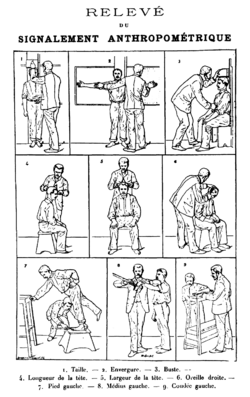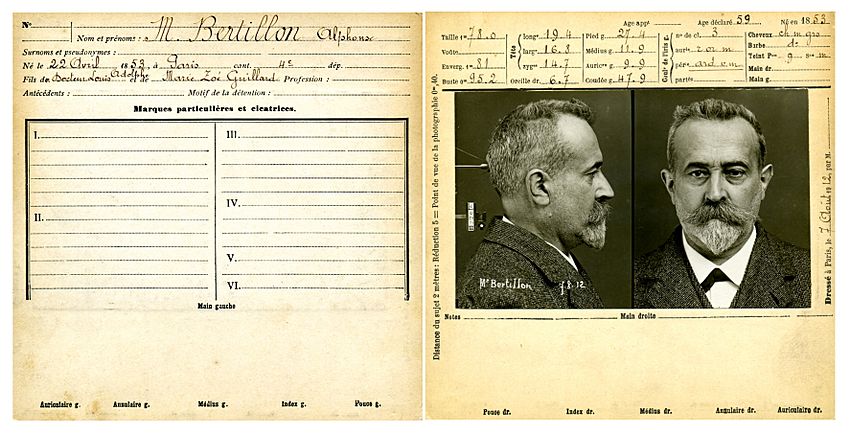Alphonse Bertillon facts for kids
Quick facts for kids
Alphonse Bertillon
|
|
|---|---|
|
Mugshot of Bertillon (self-portrait)
|
|
| Born | 22 April 1853 |
| Died | 13 February 1914 (aged 60) |
| Occupation | law enforcement officer and biometrics researcher |
| Parent(s) |
|
Alphonse Bertillon (born April 22, 1853 – died February 13, 1914) was a French police officer. He was also a researcher in biometrics, which is the study of unique body characteristics. Bertillon created a system to identify people based on their physical measurements. This system was called anthropometry.
Anthropometry was the first scientific method police used to identify criminals. Before this, police could only identify people by their name or a photograph. Bertillon's method was later replaced by fingerprinting. He also invented the mug shot, which is a photograph taken of a person's face for police records. While criminals were photographed before, Bertillon made the process standard in 1888.
Contents
Who Was Alphonse Bertillon?
Alphonse Bertillon was born in Paris, France. His father, Louis-Adolphe Bertillon, was a statistician. Alphonse had a brother, Jacques Bertillon, who was also a statistician.
After finishing school, Bertillon worked different jobs in England and France. In 1875, he joined the French army. After leaving the army, his father helped him get a low-level job at the police headquarters in Paris in 1879. Bertillon started his police career as a copyist, someone who copied documents.
Bertillon was a very organized person. He was not happy with how police identified criminals at the time. There was no clear system, and many criminals who had been arrested before were hard to identify. Also, more and more criminals were committing crimes again in France. This led him to invent his anthropometry system. He worked on his measurements in his free time. He even used the famous La Santé Prison in Paris for his research. He faced teasing from both prisoners and other police officers.

Bertillon also developed other forensics techniques. Forensics is the use of science to solve crimes. For example, he found ways to preserve footprints. He also worked on ballistics, which is the study of how bullets move. He invented the dynamometer, a tool used to measure the force used in breaking into buildings.
Bertillon published a paper in 1912. In it, he claimed that comparing 16 unique marks on a fingerprint was enough to identify someone. This idea was used for nearly 100 years to match fingerprints found at crime scenes to criminal records. Bertillon passed away on February 13, 1914, in Paris.
The Bertillon System Explained
The identification method Bertillon created is often called the Bertillon system. This system used five main body measurements:
- The length of a person's head.
- The width of their head.
- The length of their middle finger.
- The length of their left foot.
- The length of their forearm (from elbow to middle finger).
Along with these measurements, Bertillon used photography, which became known as the mugshot. These methods were combined into a system. This allowed police officers to quickly find information and pictures of criminals.
Even though the system was based on scientific measurements, it had some problems. For example, it did not work well for children or women. This was because it was mostly designed for men who had reached their full adult size and had short hair.
Bertillon and the Dreyfus Affair
Alphonse Bertillon was involved in a famous legal case called the Dreyfus affair. This happened in France in 1894 and again in 1899. Bertillon was called to testify as an expert on handwriting. He claimed that Alfred Dreyfus had written a secret document that was used against him.
However, Bertillon was not truly an expert in handwriting. His evidence was confusing and incorrect. This played a big part in Dreyfus being wrongly found guilty. Dreyfus was sentenced to life in prison on Devil's Island.
Bertillon used a very complicated system of measurements to try and prove his point. He claimed that Dreyfus had tried to hide his handwriting by imitating his own writing. This way, if anyone thought the document was in Dreyfus's hand, he could say someone else had copied his writing. Both courts believed Bertillon, and Dreyfus was convicted. The second court's decision caused a huge public outcry. Eventually, the verdict was overturned.
Many people thought Bertillon was very unusual. One observer, Maurice Paléologue, said Bertillon was "certainly not in full possession of his faculties." He described Bertillon's arguments as "a long tissue of absurdities." He also mentioned Bertillon's "moonstruck eyes" and "sepulchral voice," which made him feel like he was "in the presence of a necromancer."
Bertillon said his handwriting system was based on mathematical calculations. But in 1904, three famous mathematicians, Henri Poincaré, Jean Gaston Darboux, and Paul Émile Appell, studied his system. They concluded that Bertillon's system had no scientific value. They found that he had not used his own method correctly or presented his information properly. With this key evidence against Dreyfus proven wrong, he was finally found innocent in 1906.
See also
 In Spanish: Alphonse Bertillon para niños
In Spanish: Alphonse Bertillon para niños
Images for kids




